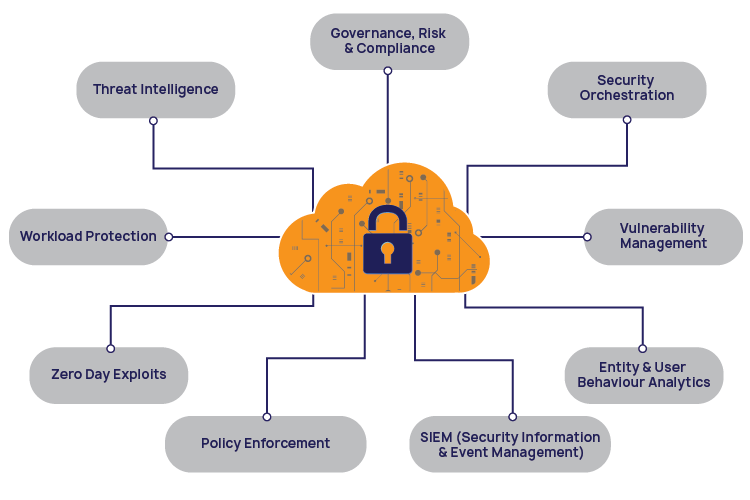

Acl Digital
5 Minutes read
AI-Powered Threat Defense: Reinventing Cloud Security for the Modern Enterprise
The complexity of vulnerabilities across multi-cloud and hybrid environments with threats dynamically attacking the systems keeps enterprises on their toes. Manual monitoring and rule-based security were never meant to catch up with the threats. The weakest link here is the visibility lagging, reacting with a delay to the threats, and the defense practicing reactiveness too much, and exposing the organization to breaches, compliance risks, and operation disruptions in turn.
AI-powered threat defense is real-time, automated, and predictive, redefining cloud security. Machine learning algorithms ingest enormous amounts of security data and highlight anomalies that conventional tools overlook. Hence, AI-driven automation enforces and refines security postures with the capacity to contain threats and reduce downtime as security postures are continuously refined. Enterprises can use AI to proactively protect their Critical Assets, Compliance Strength, and Resilience against an ever-changing cyber Landscape.
The Evolving Threat Landscape in Cloud Security
As enterprises place more trust in cloud landscapes, cyber threats are taking advantage of vulnerabilities at scales that have no precedence. The conventional security model, destined for on-premise systems, finds it impossible to keep pace with the dynamism associated with cloud computing. Hackers are increasingly resorting to automation, AI-based attacks, and multifactor assaults against the defense mechanisms to gain access; therefore, adaptive security is the only way forward.
Emergence of Advanced Cyber Threats against the Cloud Environment
Cyber threats have come a long way from when one could only worry about basic malware or phishing attacks. Now, the hackers are actively using AI-powered attacks, RaaS, and hyper-targeted exploits to break into cloud networks. Sometimes, they come with Advanced Persistent Threats (APTs) that hide inside for a long time and exfiltrate data without being caught in the act. More recently, there has been a tremendous increase in cloud-based supply chain attacks whereby criminals leverage vulnerabilities within third-party services to gain entry.
Common Vulnerabilities and Attack Vectors in Modern Enterprises
Tackling such security risks has become very challenging in cloud environments. The source of these challenges is mainly misconfiguration, weak corporate identity, loose corporate access control, and API insecurity. These factors emanate security challenges when using cloud environments. This situation allows attackers to establish attacks such as credential stuffing or lateral movement within the company’s network.
Challenges in Detecting and Responding to Threats in Real-Time
Traditional security tools use static rules to identify threats and anomaly detection, but they cannot carry on with continuously altering attack methods. The massive amount of cloud-generated data makes it challenging to separate authentic activity from possible divisions. Among this, security teams frequently face alert fatigue, astounded by false positives, while real threats go unnoticed. Attackers are likely to take advantage of the security gaps due to slow response times and complicated manual investigation processes even before the mitigation efforts can take effect.
To overcome these challenges, enterprises should have AI-powered threat detection solutions that provide real-time, automated suggestions and predictive analytics. By leveraging machine learning and behavior analysis, enterprises can proactively defend against evolving cyber threats, ensuring a more resilient cloud security posture.
How AI is Transforming Cloud Security
Artificial intelligence is revolutionizing cloud security by improving threat detection, shortening response times, and reducing human intervention in security operations. Traditional security tools often struggle with the speed and sophistication of modern cyber threats, resulting in delayed responses and increased risk. AI-based solutions address these challenges by continuously learning from large amounts of data, identifying anomalies, and automating defense mechanisms. This proactive approach enhances cloud security and enables companies to reduce risk effectively.

Benefits of AI-Driven Cloud Security
AI-Driven Threat Detection and Real-Time Response
AI-driven security systems analyze real-time network traffic, user behavior, and system logs to identify potential threats. Unlike traditional security measures based on predefined signatures, AI can detect new attack patterns, even previously unknown ones. Real-time threat detection enables immediate responses, such as isolating compromised accounts, blocking malicious activity, and alerting security teams before incidents escalate. By minimizing response time, AI significantly reduces the impact of cyber-attacks on cloud environments.
Machine Learning for Anomaly Detection and Predictive Security
Machine learning plays a key role in identifying unusual activities that could indicate a security threat. By analyzing historical data, AI models determine a baseline of normal behavior and flag anomalies that could indicate unauthorized access, data breaches, or insider threats. Predictive analytics further improves security by identifying potential vulnerabilities before they are exploited. This proactive approach can help companies stay one step ahead of cybercriminals and prevent security breaches, rather than reacting after the fact.
Automating Security Operations and Reducing False Positives
Security teams often face alert fatigue due to the many notifications from traditional security systems. AI automates threat analysis and prioritization, reducing false positives and ensuring security teams focus on real risks. Automated remediation mechanisms, such as patching vulnerabilities, remediating compromised credentials, or enforcing security policies, help streamline operations and improve the overall security posture. By integrating AI into cloud security, companies can increase efficiency while reducing the burden on security professionals.
Key Benefits of AI-Powered Threat Defense
AI-powered threat defense is reshaping cloud security by enabling faster, smarter, and more adaptive protection against cyber risks. Unlike traditional security measures that rely on predefined rules, AI continuously learns from data, detects patterns, and anticipates potential threats before they materialize. This intelligence-driven approach enhances security resilience, reduces response time, and improves efficiency. As cyber threats become more dynamic, AI provides the agility and precision needed to safeguard cloud environments while ensuring seamless business operations.
- Detects and neutralizes threats before they cause harm
- Responds instantly with precise threat containment
- Automates security tasks, freeing up IT resources
- Identifies emerging attack patterns with machine learning
- Reduces false positives, minimizing alert fatigue
- Enhances compliance by ensuring continuous security monitoring
- Improves visibility across multi-cloud and hybrid environments
- Predicts vulnerabilities and strengthens preventive security measures
- Accelerates incident response, minimizing downtime
- Adapts to evolving threats through continuous learning
Future of AI in Cloud Security
As cyberattacks become more intricate, AI will have a greater role in enhancing the safety of the cloud. Security solutions based on AI will progress past the detection and response stages, including a greater degree of automation, self-healing systems, and more accurate predictions. The combination of AI with security tools that are native to the cloud will enhance visibility, reduce risk, and improve compliance with regulations. As companies augment their digital environments with clouds, AI will have a significant role in safeguarding multi-cloud and hybrid infrastructures while taking into account new security concerns.
Emerging Trends in AI-Driven Cybersecurity
AI-powered security is shifting towards autonomous threat management, where AI not only detects and responds to attacks but also predicts and prevents them before they occur. The use of AI-driven deception techniques, advanced behavioral analytics, and adaptive threat intelligence will further strengthen cloud security.
Evolving Regulations and Compliance Considerations
As AI adoption in cybersecurity grows, regulatory bodies are introducing stricter guidelines for data privacy, AI ethics, and automated decision-making. Organizations will need to ensure AI-driven security aligns with evolving compliance frameworks like GDPR, CCPA, and industry-specific regulations.
The Growing Role of AI in Securing Hybrid and Multi-Cloud Environments
With companies having multiple platforms of operation in the cloud, AI is now important in combining security policies, monitoring the volume of cloud work, and recognizing threats that cross the clouds. Security solutions based on AI will facilitate consistent protection, automate compliance with regulations, and reduce the risk of a diverse set of infrastructure clouds.
AI is a game-changer in modern cloud security, it provides businesses with intelligent, adaptive, and proactive protection mechanisms. As the number of cyber threats increases, relying on traditional security methods is no longer practical. AI-powered threat defense increases the real-time detection of threats, automates responses, and improves the security of your postures; these features are essential to businesses that want to preserve their digital assets.
Enterprises must embrace AI-driven security to stay ahead of evolving threats, reduce vulnerabilities, and ensure compliance. By integrating AI into cloud security strategies, businesses can minimize risks, optimize operational efficiency, and build a more resilient infrastructure.
ACL Digital helps organizations implement AI-powered threat defense by providing advanced security solutions tailored to multi-cloud and hybrid environments. With expertise in AI-driven cybersecurity, ACL Digital enables businesses to automate threat detection, enhance compliance, and strengthen security operations. Adopting AI-driven security today ensures future-ready cloud protection, allowing enterprises to innovate with confidence while maintaining a robust security framework. For more information get in touch with our experts at businsess@acldigital.com.
Related Insights


Death to Prompting! Long Live Programming!

The Architecture of Agentic RAG: Reasoning-Driven AI Systems Explained


The AI Developer’s Guide to Data Formats: TOON vs. JSON and Beyond

